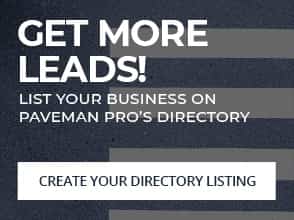Every successful asphalt business follows a specific plan; the trick is coming up with a valuable, long-term plan.
It’s not easy to think strategically when you are running a busy asphalt business. Most of your energy is taken up with daily tactics for completing today’s tasks. We operate in the here and now. We cope with change as it comes along and spend much of our time reacting. .png)
It takes effort to break free from daily tasks and find time to think about where you are as compared to where you want to be, to get a firm grasp on what you have and what you need and select your specific path to growth. If you are not planning for the future, you’re stuck in the status quo and attrition will gradually chip away at what you have.
And that’s where you start. What do you have in place right now? This analysis should include your client and customer list, your marketing program, your employees and your equipment.
Clients/Customers
For example, start with your customer base. Think about your best single customer. It is likely that your best customer is the one who spends the most money with you. Now consider where you might find more like your best customer. Make a realistic goal to find two or six or 20 others who match your best customer’s profile. Ask your best customer for help and advice. Why does he use you? Use what you learn to think through the best way to approach the prospective target.
Of course, the best thing you have going for you is the superiority of asphalt and the fact that asphalt projects are an investment in infrastructure. The catch is, all your competitors have that same advantage. So what’s the difference? Make a list of the things that set you apart from other asphalt businesses. Is it service? Price? Expertise?
Now, we’re talking about marketing
What is most important to your prospective clients? Again, the best way to learn is to pick up the phone and ask!
It’s always easier to approach prospective clients when you have something new going on. It certainly beats making cold calls that essentially say, “Just to remind you, I’m still here if you ever need me…”
Something new? Add a service. If you are a sweeper, add crack filling to your repertoire. If you are a driveway fixer, add tennis courts and stamped asphalt to your product line.
This is big news! This is an occasion for getting in touch with people, blowing your horn, attracting attention! At the same time, this is big news that you must plan. If you’re going to spend $3,000 adding new equipment and a new service, consider spending at least $3,000 to publicize it.
And, make sure you have a ongoing plan in place to keep your contacts up-to-date. Whether you call it your customer list or your mailing list, make an intentional plan to spend so many hours per week or per month adding to it and dropping the dead weight.
Constantly review and revamp your marketing program. How do you reach the right people at the right time with the right message? Are you online? Do you have a calling list/mailing list? What are you saying to prospects? Are you making clear how your asphalt service is different from the others? How’s your marketing budget? Does it need to be increased?
Your Employees – can’t live without ‘em
Your customer list is fully as valuable as your employee list – and vice versa. It is slowly dawning on business in general that when they put their employees first, those employees will, in turn, put your customers or stockholders first – and it really works! Southwest Airlines is the best example of this phenomenon. For years they have succeeded in the razor thin margins of the airline industry by making sure they have an army of happy, cheerleading employees on the front lines. They do not put the customer first. Bold? Of course it’s bold, and the bold are most likely to succeed.
Of course, the seasonality of the asphalt business makes it difficult to retain year-round employees. Most need to put together seasonal crews to succeed. What difference does it make when you have enthusiastic crews?
Plenty. Every aspect of their work becomes the best they can do.
The primary source of enthusiasm is top pay. And there are other little perks you can offer – a Friday afternoon off for exceptional productivity, or a pair of tickets to the big game, share a bonus for a particular job. The list is endless.
The secondary source is worker safety. Make sure your work practices, safety equipment, training and reporting are completely visible to your workers. Conduct periodic safety meetings. Embed safety into your company culture. Make it crystal clear to your people that their safety and well-being is top priority.
You don’t want employees grumbling about you and your company.
Again, this an aspect of running your business that just doesn’t happen on its own. You need to specifically plan to have the strongest, happiest, most enthusiastic crews in your area.
If someone were to ask your crew members about your company, what would they say? What do you hope they’ll say? Have you discussed this with them? In your employee-comes-first culture, good things naturally pop out of your worker’s mouth. If you are pinching your employees in any way, it is less clear what they might say.
Install a culture of change among all the employees in your company. Make it clear that the business is not standing still. Encourage suggestions from your people, and include them in your planning. Bring them along with you; change that is imposed on people often looks like merely adding something else to their workload. Avoid that perception. Make clear how a change is structured to raise everybody’s boat.
Years ago, there was a tiny publishing company that produced an asphalt-related magazine. The owners of the company only breezed in and out, they were seldom in the trenches. One fine day, they dropped by to share some very exciting news; they were going to increase the frequency of the magazine from nine to 12 issues per year! Isn’t that great? They assured us that they knew we could do it, then left.
In the wake of that meeting, they lost four of their 14 employees – nearly one third of their total workforce – who were already stretched beyond the maximum to produce the nine issues – because they failed to outline any plan to add to staff or increase salaries to accommodate the additional workload!
Finally, your equipment plan
Do you have one? Is it three-pronged? That is, does it provide for the very best care and use of what you now own? Are you planning for the money to be available when the useful life of your equipment ends and replacement time rolls around? Do you have an appreciation plan, where the equipment you acquire actually adds to your bottom line?
It’s all about investment
Wisely investing in your clients, your marketing, your employees and your equipment is the foundation of the kind of strategic planning that leads an asphalt business to success.




